Art Direction in Genre Films: Crafting Unique Visual Styles

Understanding Art Direction in Film: The Basics
Art direction in film refers to the visual elements that create the overall aesthetic of a movie. It encompasses everything from set design and color palettes to costumes and props. In genre films, where storytelling often relies on visual cues, art direction plays a crucial role in immersing the audience in the film's world.
Art is the most beautiful of all lies; it is a lie that tells the truth.
Think of art direction as the canvas on which the film's story is painted. Just like an artist uses color and texture to evoke emotions, filmmakers use art direction to enhance the narrative. A well-crafted visual style can instantly communicate the film's tone, whether it’s a whimsical fantasy or a gritty thriller.
For instance, in a science fiction film, futuristic set designs and sleek metallic colors can create a sense of advanced technology. In contrast, a horror film may use dark and shadowy environments to evoke fear and tension. These visual choices are not just for show; they are integral to how the audience experiences the story.
The Role of Color in Genre Film Art Direction
Color is a powerful tool in art direction, especially in genre films. It can set the mood, guide the audience's emotions, and even foreshadow events. For example, warm colors like reds and oranges might be used in a romantic comedy to evoke feelings of love and joy, while cool blues and greens might dominate a thriller to create a sense of unease.

Directors and art directors collaborate to choose color schemes that align with the film’s themes. A classic example is the use of a monochromatic palette in film noir, which emphasizes shadows and creates a sense of moral ambiguity. This careful selection of color not only enhances the visual appeal but also reinforces the story’s emotional undertones.
Art Direction Shapes Film Aesthetics
Art direction encompasses visual elements like set design, color, and costumes, which create the film's overall aesthetic and immerse the audience in its world.
Moreover, colors can signify character development. In a fantasy film, a character's journey may be depicted through the gradual shift in their wardrobe colors—from drab tones representing their struggles to vibrant hues symbolizing growth and triumph. This visual storytelling adds depth to the narrative, making it more engaging for the audience.
Set Design: Creating Immersive Worlds
Set design is a crucial aspect of art direction that contributes to world-building in genre films. Whether it's a bustling medieval town or a sleek spaceship, the set must feel authentic and believable. This authenticity draws viewers into the film's universe, making the story more impactful.
The best films are the ones that inspire you to be better than you are.
For example, in a fantasy film like 'The Lord of the Rings,' the painstakingly crafted sets of Middle-earth transport viewers to another world. The attention to detail in architecture, landscapes, and even the smallest props enhances the immersive experience. Without such thoughtful set design, audiences might struggle to suspend their disbelief.
Additionally, set design often reflects the genre's characteristics. In a dystopian film, for instance, crumbling buildings and muted colors can visually convey a sense of despair. This synergy between set design and genre conventions not only helps to establish the film's identity but also enriches the storytelling.
Costume Design: Reflecting Character and Theme
Costume design is another vital element of art direction that plays a significant role in genre films. Costumes can communicate a character's personality, social status, and even their arc throughout the story. In superhero films, for instance, costumes often embody the character's powers and ideals, visually representing who they are.
Consider how the vibrant, form-fitting suits in a film like 'Black Panther' not only enhance the character's heroic stature but also reflect the cultural heritage of Wakanda. Each detail in the costume—from patterns to colors—contributes to the overall narrative and helps the audience connect with the character's journey.
Color Influences Emotion and Theme
Color plays a critical role in art direction, setting the mood and guiding audience emotions while reinforcing the film's themes through careful selection.
Moreover, costumes can serve as visual metaphors. In a horror film, the gradual deterioration of a character's clothing might symbolize their descent into madness. This interplay between costume design and storytelling enriches the viewer's experience, making it more memorable.
Iconic Visual Styles in Different Genres
Different genres often have distinct visual styles that audiences have come to recognize and expect. For example, the vibrant colors and exaggerated aesthetics of musicals create a lively atmosphere, while the muted tones and stark contrasts typical of thrillers evoke tension and suspense. These visual cues help establish the film's identity even before the story unfolds.
An iconic example is Tim Burton's unique style in films like 'Edward Scissorhands,' where whimsical yet dark visuals perfectly encapsulate the film's themes of isolation and acceptance. This signature look not only sets the film apart but also creates a cohesive visual experience that resonates with audiences.
Understanding these genre-specific visual styles is essential for filmmakers. By leveraging these conventions, they can effectively communicate the essence of their story and engage viewers on a deeper level. Art direction, therefore, becomes a vital tool in not just telling a story but also shaping the audience's emotional journey.
The Collaboration Between Directors and Art Directors
The relationship between directors and art directors is crucial in shaping a film’s visual identity. Directors often have a specific vision for their film, and art directors translate that vision into tangible visuals. This collaboration involves ongoing discussions about themes, emotions, and how to best convey those through art direction.
For instance, in a film like 'Blade Runner,' director Ridley Scott worked closely with art director Syd Mead to create a dystopian future that feels both alien and familiar. Their partnership ensured that the film's visuals aligned with its themes of humanity and technology, creating a lasting impact on audiences.
Collaboration Drives Visual Identity
The partnership between directors and art directors is essential for translating a film's vision into cohesive visuals that enhance storytelling.
This collaborative process is not just about aesthetics; it's about storytelling. By working together, directors and art directors can create a cohesive narrative that resonates with viewers. The result is a film that not only looks stunning but also tells a compelling story through its visuals.
The Future of Art Direction in Genre Films
As technology continues to evolve, so too does art direction in genre films. With advancements in CGI and virtual reality, filmmakers have new tools at their disposal to create immersive worlds that were once unimaginable. This evolution opens up exciting possibilities for storytelling and visual expression.
For example, films like 'Avatar' have demonstrated how CGI can enhance the art direction, creating lifelike environments that transport audiences to other realms. However, there remains a delicate balance between technology and traditional art direction techniques, ensuring that the story remains at the forefront.

Looking ahead, the future of art direction in genre films promises to be innovative and dynamic. As filmmakers experiment with new technologies and techniques, we can expect to see even more unique visual styles that challenge conventions and push the boundaries of storytelling.